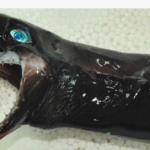Viper Dogfish:
The ocean’s depths are home to some of the most enigmatic creatures on Earth, and among them is the Viper Dogfish. This small but fierce predator is a remarkable example of adaptation to life in extreme environments. The Viper Dogfish, scientifically known as Trigonognathus kabeyai, is a species of deep-sea shark that belongs to the family Etmopterus. Despite its small size, reaching only about 54 cm (21 inches) in length, this shark is a formidable predator in its habitat. The name “Viper” is a nod to its snake-like appearance, particularly its long, narrow head and large, protruding teeth that give it a fearsome look.
The Habitat of the Viper Dogfish
The Viper Dogfish is native to the deep waters of the Pacific Ocean, primarily around Japan, Taiwan, and the Philippines. It thrives at depths ranging from 270 to 360 meters (approximately 885 to 1,180 feet), where the environment is cold, dark, and high in pressure. These extreme conditions are inhospitable to most life forms, but the Viper Dogfish is perfectly adapted to this harsh environment.
The Unique Physical Features of the Viper Dogfish
The Viper Dogfish is easily recognizable due to its distinct physical characteristics. Its most striking feature is its large, fang-like teeth, which are razor-sharp and protrude from its jaws even when the mouth is closed. These teeth are perfectly designed for catching and holding onto slippery prey in the deep sea. The shark’s body is slender and covered in rough, spiky scales called dermal denticles, which provide protection and reduce friction as it swims.
Hunting Techniques of the Viper Dogfish
The Viper Dogfish is an ambush predator, relying on its stealth and speed to catch prey. Its large mouth can open wide enough to swallow prey almost half its size. When hunting, the Viper Dogfish uses its powerful jaws to quickly snap up unsuspecting fish and squid. Its hunting strategy is highly effective in the dark, where it uses its other senses to locate prey in the pitch-black waters.
The Role of Bioluminescence in the Viper Dogfish’s Life
One of the most fascinating aspects of the Viper Dogfish is its ability to produce light, a phenomenon known as bioluminescence. This shark has light-emitting organs called photophores on its body. These photophores serve multiple purposes, such as attracting prey, communicating with other Viper Dogfish, and camouflaging themselves against the faint light from above. This ability to glow in the dark is crucial for survival in the deep-sea environment, where sunlight is nearly non-existent.
Challenges in Studying the Viper Dogfish
Studying deep-sea creatures like the Viper Dogfish presents numerous challenges. The depths at which they live are not easily accessible, requiring advanced technology such as submersibles and remotely operated vehicles (ROVs) to observe them. Additionally, the extreme conditions of their environment make it difficult to keep these creatures alive for study in laboratories. As a result, much of what we know about the Viper Dogfish comes from rare encounters and occasional captures by deep-sea fishing operations.
Conservation Status and Threats
Currently, the Viper Dogfish is not considered endangered, largely due to its deep-sea habitat, which is less affected by human activities than shallower waters. However, deep-sea ecosystems are increasingly threatened by activities such as deep-sea fishing, mining, and pollution. These threats could potentially impact the Viper Dogfish and other deep-sea species, highlighting the need for careful management and conservation efforts.
The Viper Dogfish in Pop Culture
While not as widely recognized as other deep-sea creatures like the anglerfish, the Viper Dogfish has captured the imagination of those interested in the ocean’s mysteries. Its unique appearance and predatory nature make it a popular subject in documentaries, marine biology studies, and even in speculative fiction that explores the unknown depths of the ocean.
The Ecological Importance of the Viper Dogfish
The Viper Dogfish plays a vital role in its ecosystem, helping to regulate the populations of smaller fish and squid in the deep-sea environment. As a predator, it is an integral part of the food chain, contributing to the balance of its ecosystem. Understanding its role can provide insights into the health and dynamics of deep-sea environments, which are still largely unexplored.
Conclusion
The Viper Dogfish is a remarkable example of the diversity and adaptability of life in the deep sea. With its unique physical features, hunting strategies, and bioluminescent abilities, this small shark is a testament to the wonders of the ocean’s depths. Although much about the Viper Dogfish remains a mystery, what we do know highlights the incredible complexity and beauty of marine life. As technology advances and exploration continues, we can look forward to learning even more about this intriguing species and the deep-sea ecosystems it inhabits.
FAQs
What does the Viper Dogfish eat?
The Viper Dogfish primarily feeds on small fish, squid, and crustaceans, using its sharp teeth and powerful jaws to capture and consume its prey.
Can the Viper Dogfish be kept in an aquarium?
Due to its deep-sea habitat and specific environmental needs, the Viper Dogfish is not suitable for keeping in aquariums. Its survival in captivity would be highly challenging.
How does the Viper Dogfish use its bioluminescence?
The Viper Dogfish uses bioluminescence to blend in with its surroundings, attract prey, and communicate with other Viper Dogfish in the dark depths of the ocean.
Is the Viper Dogfish endangered?
The Viper Dogfish is not currently considered endangered, but deep-sea ecosystems face increasing threats from human activities, which could impact its population in the future.
Where can I see a Viper Dogfish?
The Viper Dogfish lives in deep waters of the Pacific Ocean and is rarely seen by humans. It is most often encountered by deep-sea fishing operations or observed by submersibles in its natural habitat.


